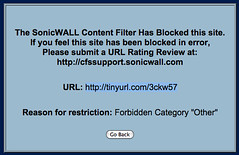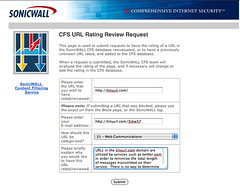On Wednesday, I visited the Panera in Levittown, PA to sip a diet soda and use their WiFi. This is supposed to be an amenity for customers. I had never taken advantage of it before.
I saw a Twitter post (aka “tweet”) from someone I am following in my Twitterific window, and I wanted to know what they were talking about. I clicked on the URL that was embedded in the tweet and saw this {see the first screenshot}:

SonicWall CFS Blocking TinyURL.com:
This makes Twitter almost unusable, in my
opinion. [ Screenshot: Dave Aiello on Flickr ]
For the record, the URL depicted resolves to a YouTube copy of a Cheetos commericial. I didn’t find that out until I got home and had time to look, probably 12 hours after the situation I’m describing.
At the time I thought, “There’s pretty much no way I am going to remember this later today. I’ll have to reread all the tweets on my ‘with friends’ timeline and hope that I remember this specific one.” I was sure I wouldn’t remember because I had a meeting with a potential client in Center City Philadelphia scheduled for around lunchtime, and those types of meetings have a tendency to clear my head of previous ancillary thoughts.
Twitter is basically unusable in this environment from a followers perspective if SonicWall decides it’s not going to allow requests for any URL issued by TinyURL.com.
I considered my options and none of them looked good. I guess I could have written the tweet down and some information about the context if that was important, but I didn’t think of that.

Submitting a URL Rating Request:
“… It’s unfair to assume that tinyurl used in this
context is a means of obfuscation.” [ Screenshot:
Dave Aiello on Flickr ]
I decided to take SonicWall’s advice and submit a URL Rating Review request. In the HTML form shown in the second screenshot, I made the case that access to TinyURL should be allowed. My complete statement is as follows:
“URLs in the tinyurl.com domain are utilized by services such as twitter.com in order to minimize the total length of messages transmitted on their service. There is no way to determine what the content or nature of the ultimate destination site is. It’s unfair to assume that tinyurl.com used in this context is a means of obfuscation.”
I went about my business of researching my potential client and forgot about the situation until I got home. Now that a few more hours have passed, I have a couple of questions:
- How many other actively-managed content filtering systems ban TinyURL just because it can be used to mask nasty things?
- How does this affect penetration of Twitter into Corporate America and institutions such as schools?
- What happens in more restrictive countries such as China? Do they ban services like TinyURL because of its potential to undermine the authority of official sources of information?
I guess it takes an experience like this for me to realize how fragile freedom of access to services on the Internet is. What I’m illustrating here is clearly a side-effect of an overly restrictive policy, but you can see the potential for this access hurdle to exist in its present form indefinitely.
If I get a response from SonicWall to my URL Rating Request, I will certainly update the story.